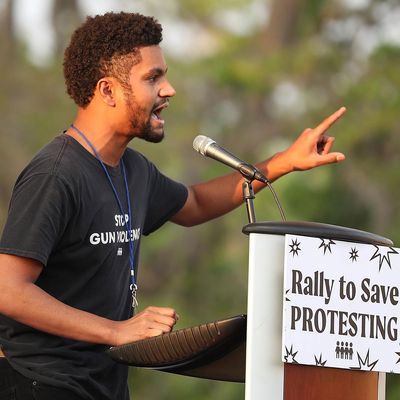
In 2018 and 2020, progressive insurgents seemed to crush high-profile moderates with regularity. Alexandria Ocasio-Cortez throttled Joe Crowley, the Queens Democratic boss and a potential successor to Nancy Pelosi. Ayanna Pressley unseated Mike Capuano, a ten-term incumbent. Jamaal Bowman, a former public-school principal, swatted away Eliot Engel, who chaired the House Foreign Affairs Committee. And Cori Bush, in her second bid for Congress, edged out ten-term incumbent Lacy Clay.
This year has been something of a course correction. Centrist incumbents are no longer falling to unabashedly left-wing upstarts. By FiveThirtyEight’s count, 11 candidates endorsed by Bernie Sanders, Ocasio-Cortez, and various progressive organizations such as Justice Democrats, Our Revolution, and the Sunrise Movement entered the 2022 primary season. Only one was victorious: Jamie McLeod-Skinner, who defeated Kurt Schrader, a Biden-endorsed congressman from Oregon. Others such as Nina Turner in Ohio, Jessica Cisneros in Texas, and Alessandra Biaggi in New York came up short against well-funded moderates. In the cases of Cisneros and Turner, it was their second run against the same candidates. While Cisneros came close to defeating Henry Cuellar, perhaps the House’s most conservative Democrat, Turner backslid against Shontel Brown.
Why did these various movement candidates fail to break through? Simply put, it’s very hard to beat incumbents, and the 2018 and 2020 cycles are better understood as outliers, not the norm. Upsets are upsets for a reason — the candidate with more money, more name recognition, and more institutional support triumphs most of the time. And centrist incumbents, generally, have not been caught flat-footed in 2022. Ocasio-Cortez was a remarkable candidate, but she was up against a congressman who lived in Virginia and barely campaigned in his district. Before 2018, successful left-wing challenges were rare enough that many members of Congress never took them seriously. When Hillary Clinton survived the Sanders insurgency in the 2016 presidential primary, Establishment Democrats took the wrong lessons: that Sanders was a fluke, Clinton was still safe, and shock victories like Michigan didn’t portend anything else. The electorate, from 2016 through 2020, was often in an anti-Establishment mood.
New York, in 2022, has been a microcosm of the new national trend — or representative of a reversion to an old trend. Because of the chaos of the redistricting process, New York had two primary seasons this year, one for statewide races and the State Assembly and another for the State Senate and the U.S. House. Many primary campaigns were waged, and in almost all cases, the incumbents won. There was, however, a silver lining for the left. Incumbent victories, in New York at least, no longer meant centrists merely turned away progressives. Socialist and progressive incumbents also faced challenges from the right, some of them exorbitantly funded. All of these challenges failed. And when seats were open, like a closely watched State Senate contest in Manhattan and Queens, the socialist was able to prevail over a moderate who heavily outspent her.
In 2018 and 2020, the logic among progressives was that the ideal campaign was a primary in which stark contrasts could be drawn between the incumbent and the challenger. Doddering, middle-aged white men like Engel and Crowley were ripe for the picking. In 2022 — and likely beyond — moderates will be far more prepared to face down insurgencies. Outside super-PACs such as the Democratic Majority for Israel and even the Police Benevolent Association are ready to spend aggressively to defend like-minded candidates. Pelosi herself has intervened in primaries, marshaling her immense resources to save Cuellar in Texas. For progressives going forward, the bar to clear is much higher. There may never be another lazy, Virginia-dwelling House power broker or long-serving New Yorker riding out a pandemic in Maryland to easily unseat.
Far more success, these days, has come in the incumbent-free open races. FiveThirtyEight’s count found 14 out of 25 progressives won in 2022, a win rate above 50 percent. Some of them include Maxwell Frost, a Sanders-backed Florida activist who has been dubbed Gen Z’s first incoming congressman, and Summer Lee, a state lawmaker from Pennsylvania who survived an onslaught of AIPAC spending to edge out attorney Steve Irwin. Some of the progressives will have tough general-election fights, like Mandela Barnes, who is attempting to defeat Wisconsin’s hard-right Republican senator.
Why are incumbent-free races now better for the left? While crowded primaries can make it challenging for candidates to distinguish themselves from one another, they can also benefit contenders with clearly identifiable brands and endorsers. Over the past four years, the groups that make up the progressive political space have reached a degree of maturity. Strong left-wing candidates can now fundraise effectively, especially if outside organizations and endorsers coalesce around them early enough. In certain races, such as Frost’s in Florida, these Democrats can emerge even as consensus candidates, rallying institutional support as any well-wired moderate would. Barnes in Wisconsin was strong enough to clear the primary field before Election Day. The more the left can behave, in some ways, like the Establishment they’re trying to topple, the better off they’ll be.



























